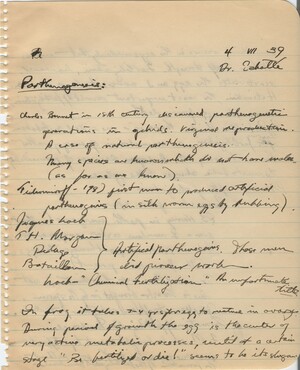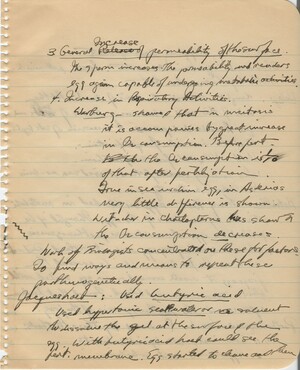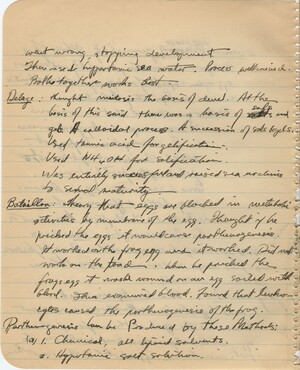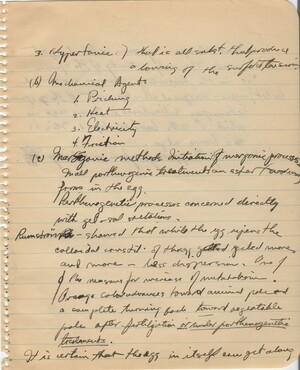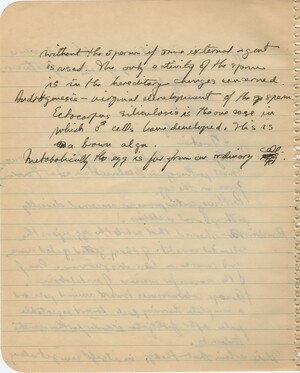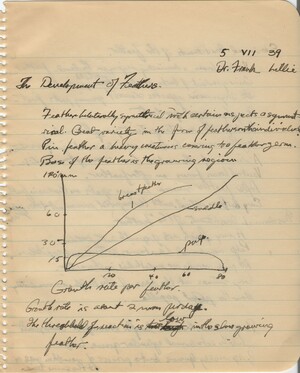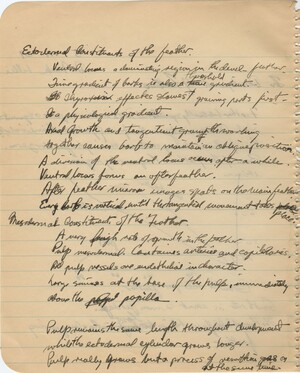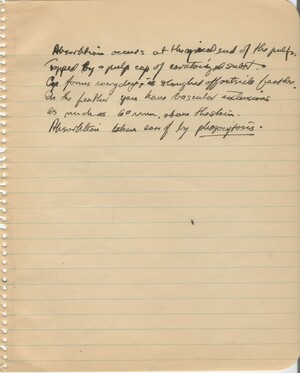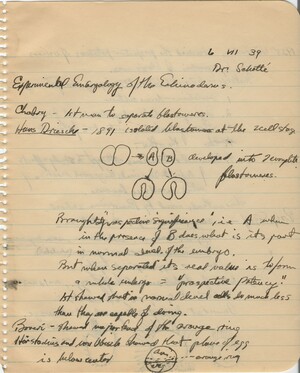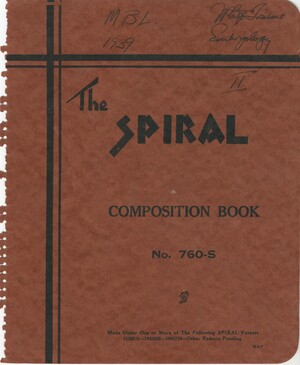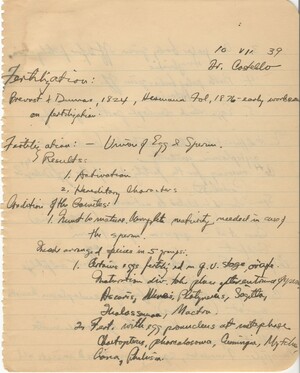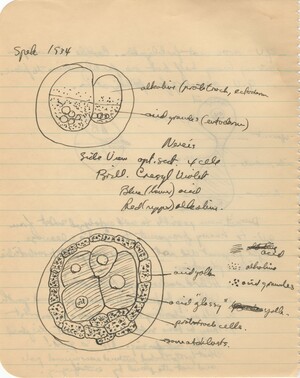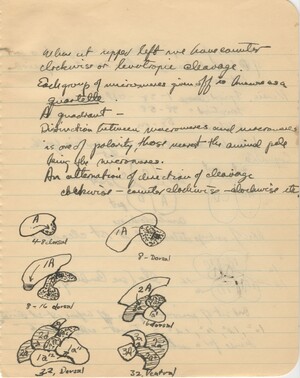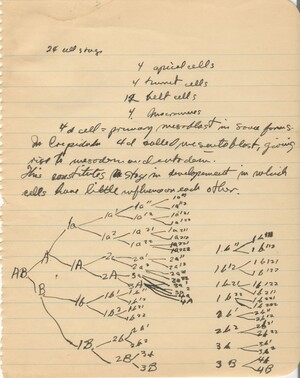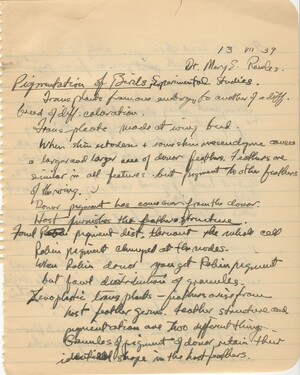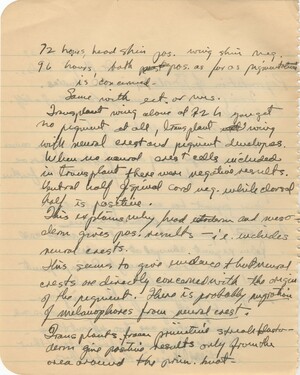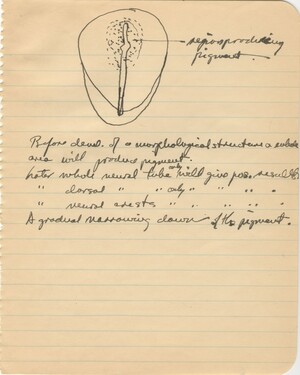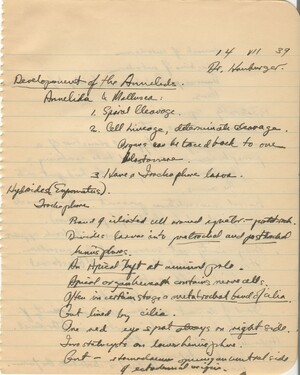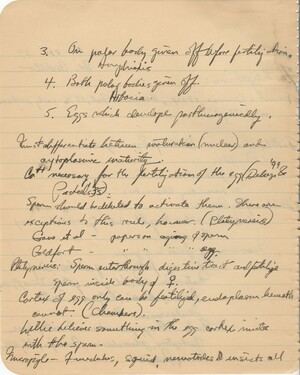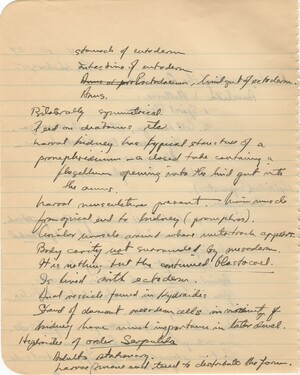Photographs
Notes from Oscar Schotte's lecture. Trinkaus begins notes on parthenogenesis with a brief history (beginning with Charles Bonnet) and some general notes
Notes from Oscar Schotte's lecture. Trinkaus continues his notes from the previous page on parthenogeneis with some thoughts from F.R. Lillie, and then the beginning of an outline on the 'Processes after fertilization'
Notes from Oscar Schotte's lecture. Trinkaus continues his outline from the previous page on parthenogenesis with 'General increase of permeability of the surface', 'Increase in respiratory activities', and notes on Jacques Loeb
Notes from Oscar Schotte's lecture. Trinkaus continues his outline from the previous page on parthenogenesis with information on Delage, Battalion, and 'Parthenogenesis can be produced by these methods"
Notes from Oscar Schotte's lecture. Trinkaus continues his outline from the previous page on the methods of producing parthenogenesis and includes notes on Runstrom's experiments
Notes from Oscar Schotte's lecture. Trinkaus concludes his notes on parthenogenesis with a few lines on androgenesis
Notes from Frank Lillie's lecture. Trinkaus begins his notes on Lillie's lecture on 'The development of feathers' with some information about how feathers grow (including a graph)
Notes from Frank Lillie's lecture. Trinkaus continues his notes from the previous page on feather development with sections 'Ectodermal constitutuants of the feather' and 'mesodermal constituants of the feather'
Notes from Frank Lillie's lecture. Trinkaus concludes his notes from the preivous page on the development of feathers.
Notes from Oscar Schotte's lecture. Trinkaus begins his notes on 'Experimental embryology of the Echinoderms" with historical background from Hans Driesch (with diagram), Boveri, and Horstadius
Signed "J. Philip Trinkaus, M.B.L., 1939, Embryology, II"
Notes from Donald Costello's lecture. Trinkaus begins the lecture notes with a line on historical work, then starts an outline with "Fertilization:--Union of Egg & Sperm". "Conditions of the Gametes" is next, and Trinkaus begins a list of 5 groups (the first two are on this page)
Notes from Donald Costello's lecture. Trinkaus continues his notes on Egg centrifugation with two diagrams (most likely Nereis)
Notes from Donald Costello's lecture. Trinkaus concludes his notes on the centrifugation of eggs with information on "Isolation of blastomeres"
Notes from Donald Costello's lecture. Trinkaus begins notes on "Cell Lineage & Spiral Cleavage" with a list of researchers, their organism, and the journal citation. Trinkaus then begins with general notes on which animals exhibit spiral cleavage and how it happens
Notes from Donald Costello's lecture. Trinkaus continues his notes on spiral cleavage with information on the development of micromeres, the direction of cleavage and six cell lineage diagrams
Notes from Donald Costello's lecture. Trinkaus continues his notes on spiral cleavage with information about Nereis and Crepidula (includes three cell lineage diagrams)
Notes from Donald Costello's lecture. Trinkaus continues his notes on spiral cleavage and cell lineage with information about Crepidula and a cell lineage chart (cell phylogeny)
Notes from Mary Rawles' lecture. Trinkaus begins his notes with information on "Pigmentation of Birds, Experimental Studies" including information on transplantation experiments
Notes from Mary Rawles' lecture. Trinkaus continues his notes from on transplantation experiments for bird pigmentation from the previous page. Trinkaus gives details about the experimental procedure and pays special attention to the role of the neural crest
Notes from Mary Rawles' lecture. Trinkaus concludes his notes on pigmentation experiments in birds with a diagram of the neural tube with cells that produce pigment
Notes from Viktor Hamburger's lecture. Trinkaus begins notes on "Development of the Annelidas" with a three-point list of features of "Annelida & Mollusca", then begins a list of features of "Hydroides (Eupomatus)"
Notes from Donald Costello's lecture. Trinkaus continues his notes on fertilization from the previous page with points 3-5. The rest of the page is devoted to notes on fertilization from different researchers and in different organisms
Notes from Viktor Hamburger's lecture. Trinkaus continues his notes from the previous page on Hydroides with a long list of traits that define the organism

